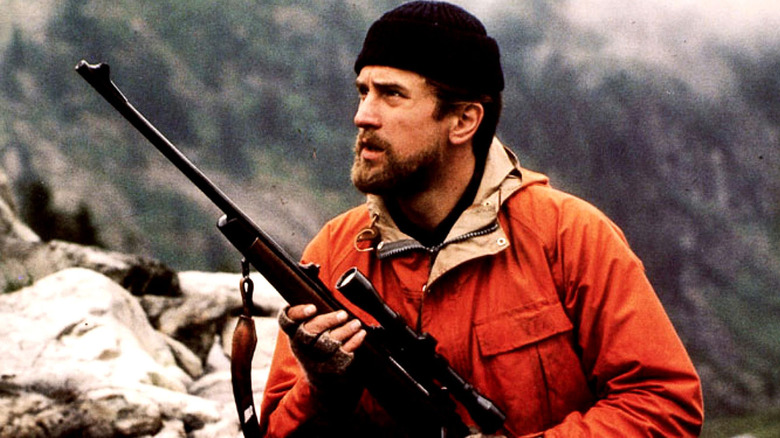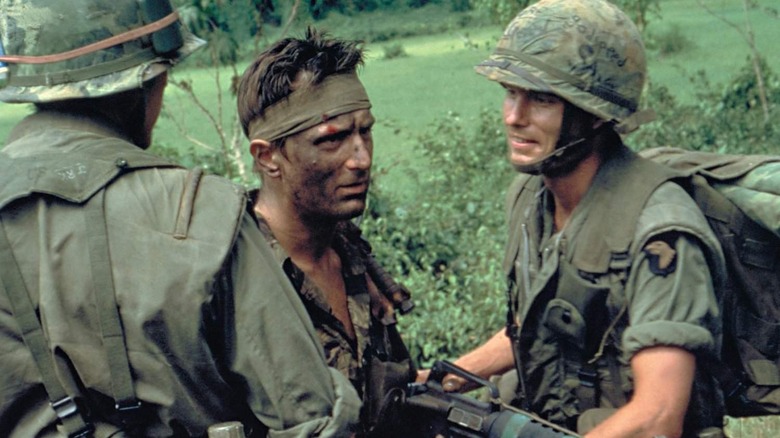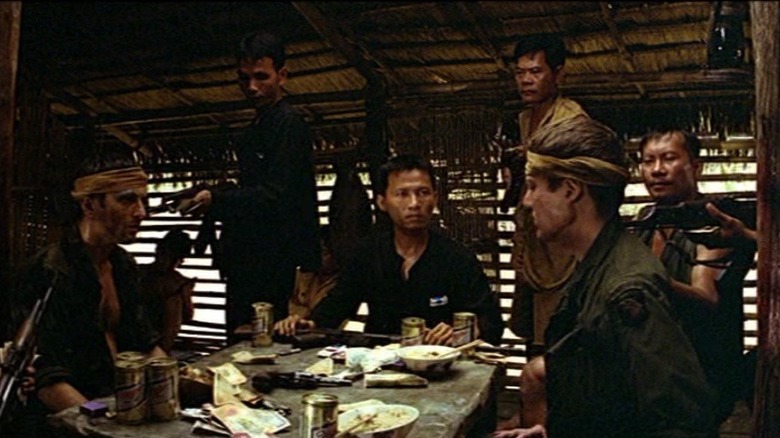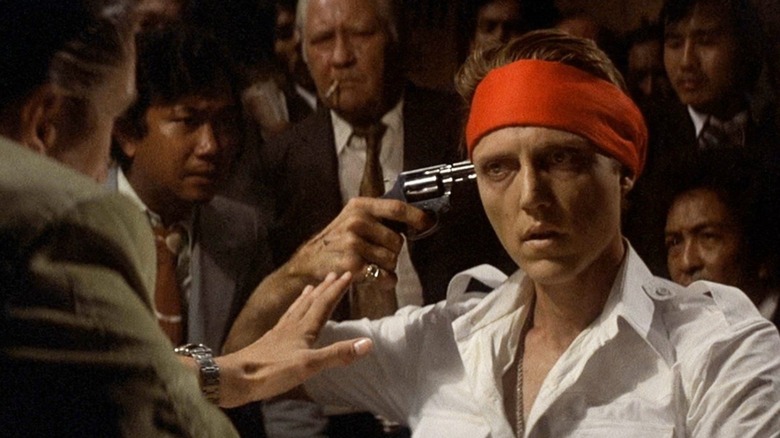The Deer Hunter Controversy Explained: The Horror Of Russian Roulette
Released in 1978, "The Deer Hunter" was highly acclaimed by critics and earned the Academy Award for Best Picture. The gripping war drama tapped into a cultural nerve in its exploration of post-Vietnam America's psychic traumas and search for peace. So it should come as no surprise that a fair amount of political controversy came with the film's reception.
"The Deer Hunter" follows three friends from a blue-collar, Russian Orthodox community in Pennsylvania — Michael (Robert De Niro), Nick (Christopher Walken), and Steven (John Savage). The first hour of the film depicts Steven's wedding, only two days before their departure for basic training, in methodical and novelistic detail. Director Michael Cimino stretches out the opening scene to build up the sense of dread in their last few moments of normalcy.
The film depicts the shock of being thrown into battle by abruptly cutting from the friends' quiet hunting trip to a terrifying combat scene in a burning village. The three friends are reunited only to be captured by the Vietcong. They eventually manage to escape and the rest of the film details their post-war trauma: Michael feels estranged, Steven loses his legs and refuses to see his wife, and Nick disappears into Saigon's underground gambling where Michael returns to try and rescue him. But during their time as prisoners of war, they were forced to play a cruel game of Russian roulette. It's in this particular scene that "The Deer Hunter" stirred up controversy.
America Was Divided About the Vietnam War
At the time of its release in 1978, the Vietnam War had only been over for a few years, and American cinema had largely avoided the subject, worn out from the televised violence and protests. With some exceptions, including the conservative propaganda "The Green Berets" from western hero John Wayne, there were few cinematic explorations of the Vietnam War on-screen during the mid-1970s. Vietnam was seen as a failed and pointless war, an embarrassing stain on America's military history that we would rather forget. The public vitriol surrounding our involvement in Vietnam resulted in veterans being scorned and literally spit on by society; they were made scapegoats of the country's discomfort with the war.
"The Deer Hunter" ushered in a cinematic movement that would give voice to veterans who were suffering from acute trauma. Along with the romantic melodrama "Coming Home" and Francis Ford Coppola's dreamlike epic "Apocalypse Now," Michael Cimino's "The Deer Hunter" amplified veterans' struggles and the madness of the Vietnam War during the late 1970s. In particular, the scene where Michael spares a deer's life symbolizes the new brand of masculinity seen in post-Vietnam films: a rejection of America's infatuation with macho violence and a vulnerable willingness to confront psychological damage. Films during the 1980s would abandon that ethos for more conservative politics. The beefcake heroics in "Rambo" movies, for example, mirrored President Ronald Reagan's attempt to rehabilitate America as a virile, successful world power.
The Vietnamese Were Sadistic Caricatures
Many accused "The Deer Hunter" of depicting the Vietnamese enemy in a racist manner, mainly in the legendary Russian roulette scene. Pauline Kael wrote in The New Yorker (via New York Times) that the "Vietcong are treated in the standard inscrutable‐evil Oriental style of the Japanese in the Second World War, movies ... The impression a viewer gets is that if we did some bad things there we did them ruthlessly but impersonally; the Vietcong were cruel and sadistic." According to Vanity Fair, Jane Fonda, who was making waves in her support of the anti-war movement, also denounced the film as "racist" (despite not having seen it).
The Vietnamese are only a small part of the "The Deer Hunter," but LA Weekly (via New York Times) observes that Cimino paints every one of them as "sweaty, crazy, vicious and debauched." During the sole combat scene, the North Vietnamese Army destroys a village and savagely kills an innocent woman and young child, then Michael roasts him to death with a flamethrower. Cimino's famous Russian roulette scene frames the enemy as babbling and guffawing creatures routinely slapping their prisoners and forcing them to play a barbarous game by holding guns to their heads. The Vietnamese characters are othered by the use of uncomfortable close-ups and lack of subtitles. By the end of the distressing sequence, Michael and his friends manage to escape and brutally kill their kidnappers.
In these instances, audiences are invited to view the Vietnamese as fundamentally evil. Despite decades of "movies with Nazi devils, Japanese devils and then communist devils," writer Hans Koning couldn't recall any "in which 'the enemy' is shown as quite so devilish," Bright Lights Film Journal reports. Numerous critics censured Cimino for presenting the Vietnamese community as caricatures with no human emotion. Writer Studs Terkel argues in his book "The Spectator: Talks About Movies and Plays with the People Who Make Them" that the film's racism made it "the perfect vehicle to assuage any feelings of guilt we may still suffer" for the war, in turn justifying America's involvement in Vietnam to audiences. "The Deer Hunter" villainizes the Vietnamese in an exaggerated way in order to provide frustrated Americans catharsis for what many believed was a fruitless war.
The Russian Roulette Scenes Were a Lie
Many critics were upset with Cimino's invention of the Russian roulette game, the film's harrowing centerpiece in which our protagonists must fire a pistol at their own head in the hopes that there is no bullet in the chamber. During the Academy Awards ceremony, 13 members of Vietnam Veterans Against the War protested against the scene's inaccuracy, claiming that it was offensive to the genuine horrors that Vietnam soldiers went through. According to many war reports, there was zero documented proof that the Vietcong ever made captives play the deadly game. Many believed Ciminio was perverse for violating the truth, and censured him for manufacturing "a bloody lie," as journalist Peter Arnett wrote in the Los Angeles Times (via Vanity Fair). Meanwhile, according to Bright Lights Film Journal, Pauline Kael tied the roulette invention to the film's inherent racism, arguing that it was a "metaphor for the General Westmoreland theory that Asians don't value human life the way we do."
However, Roger Ebert defended the inclusion of the scene based on artist merit, stating, "It is the organizing symbol of the film: Anything you can believe about the game, about its deliberately random violence, about how it touches the sanity of men forced to play it, will apply to the war as a whole. It is a brilliant symbol because, in the context of this story, it makes any ideological statement about the war superfluous." Just as the deer symbolizes Michael's passive transformation after experiencing the savagery of war, the Russian roulette scenes can be interpreted as a metaphorical depiction of Vietnam's senseless barbarity. As Bright Lights FIlm Journal says, some viewers believe it represents the "cruel and random chance by which war picks it victims," and how your life is left to fate.
The Russian roulette scene is one of the most effective and harrowing moments in the film, especially due to Robert De Niro's masterful performance. Yet for many, it emphasized the problematic nature of post-Vietnam culture when a divided nation tried to grapple with the damage of a hotly-debated war.



